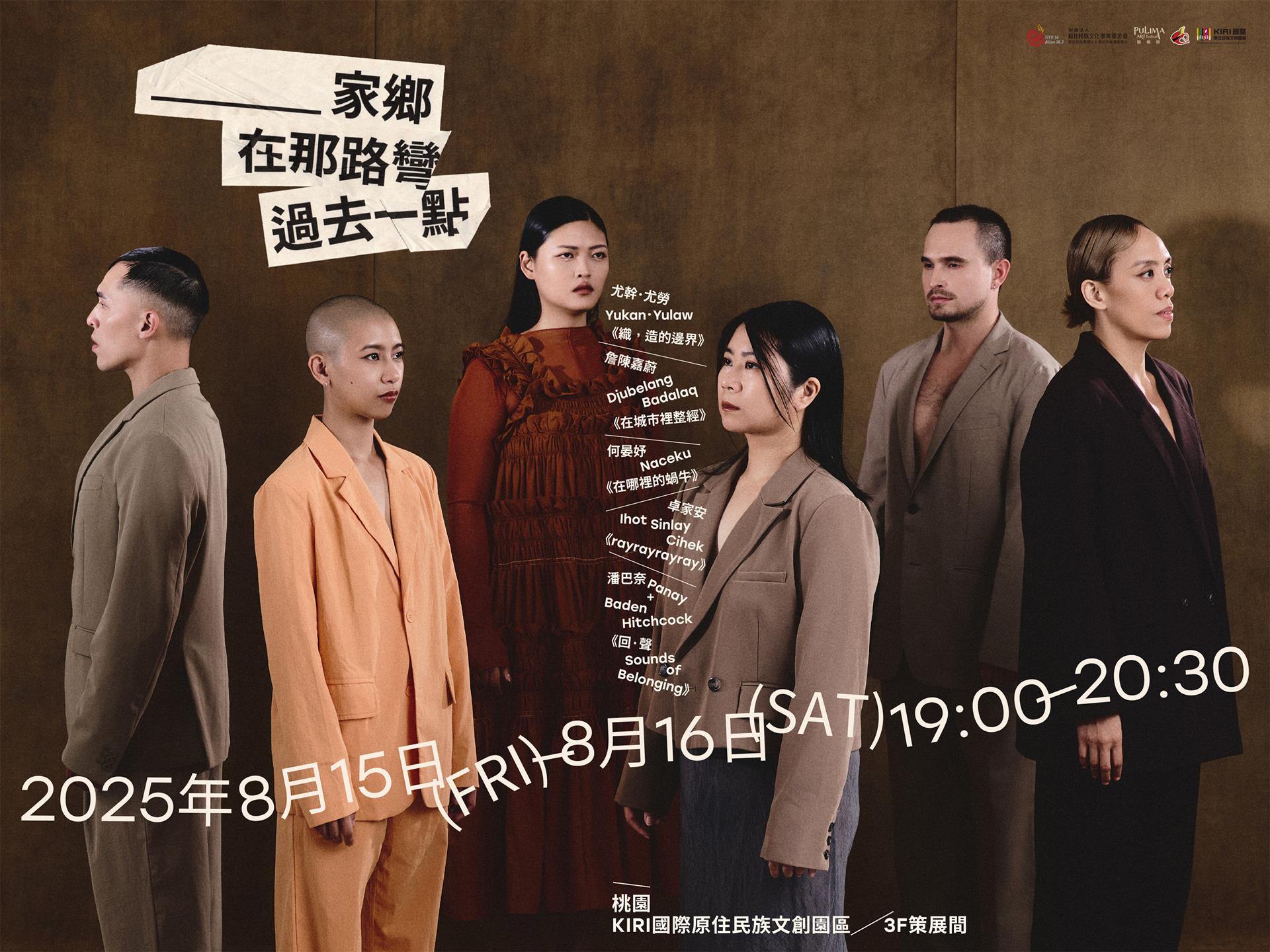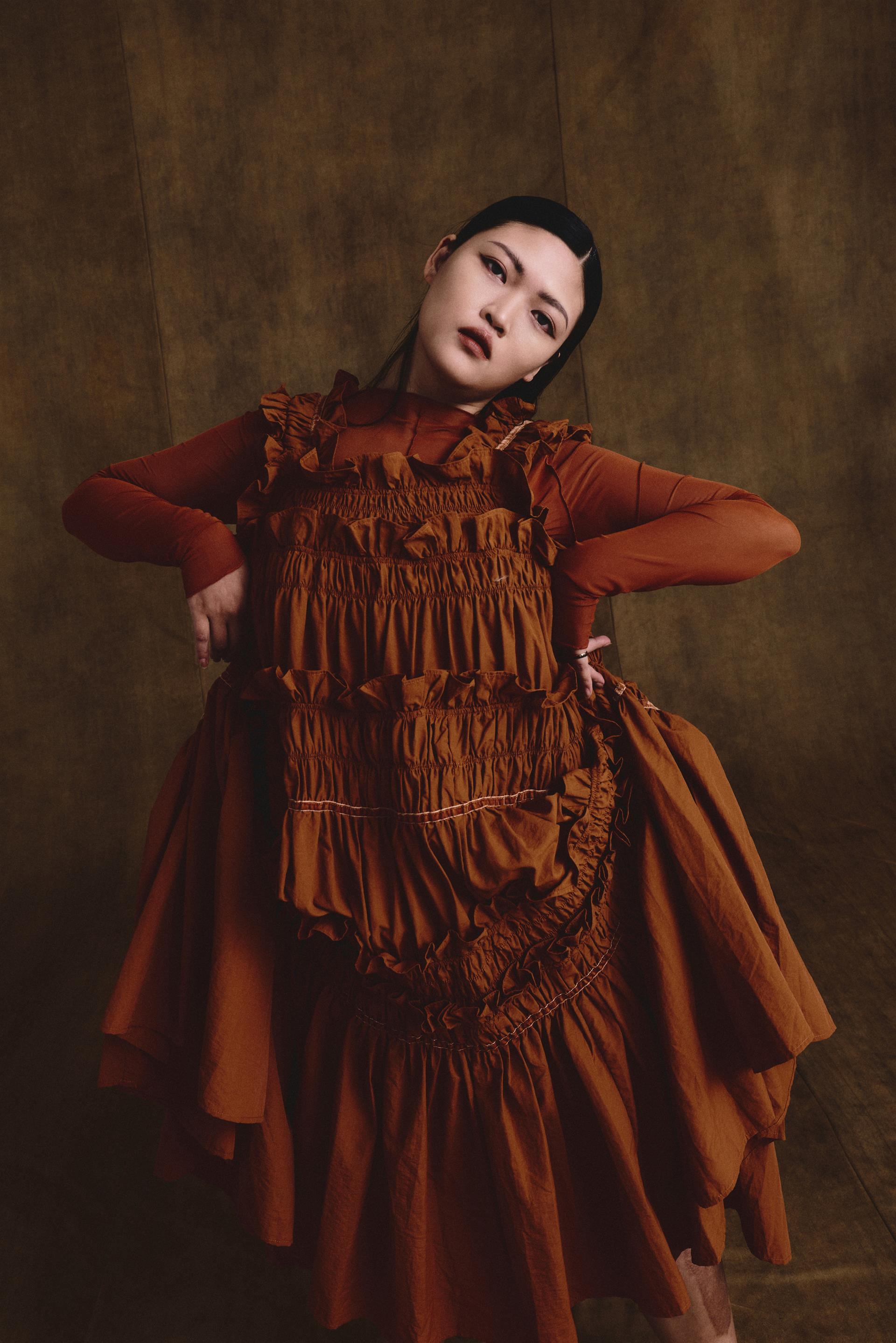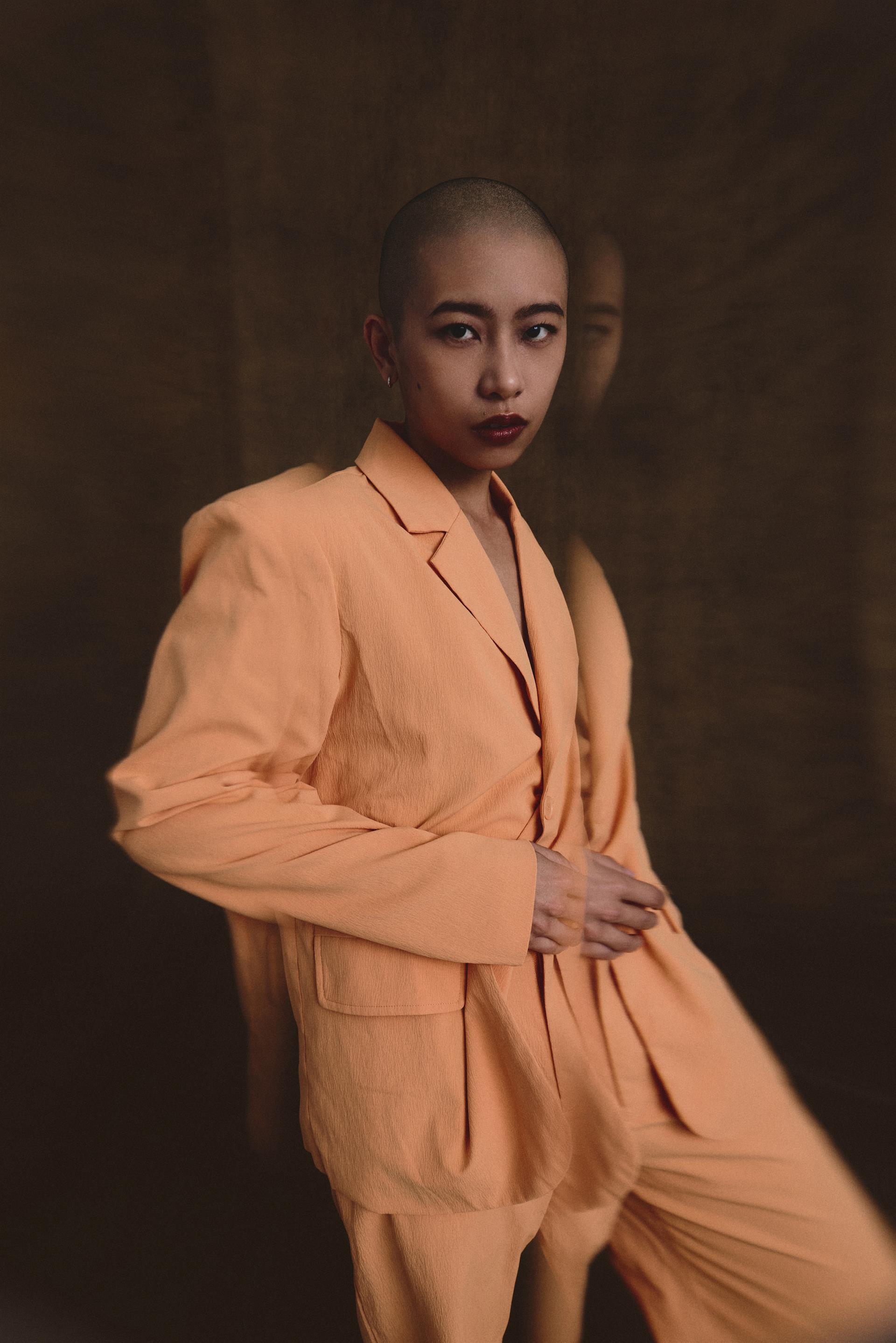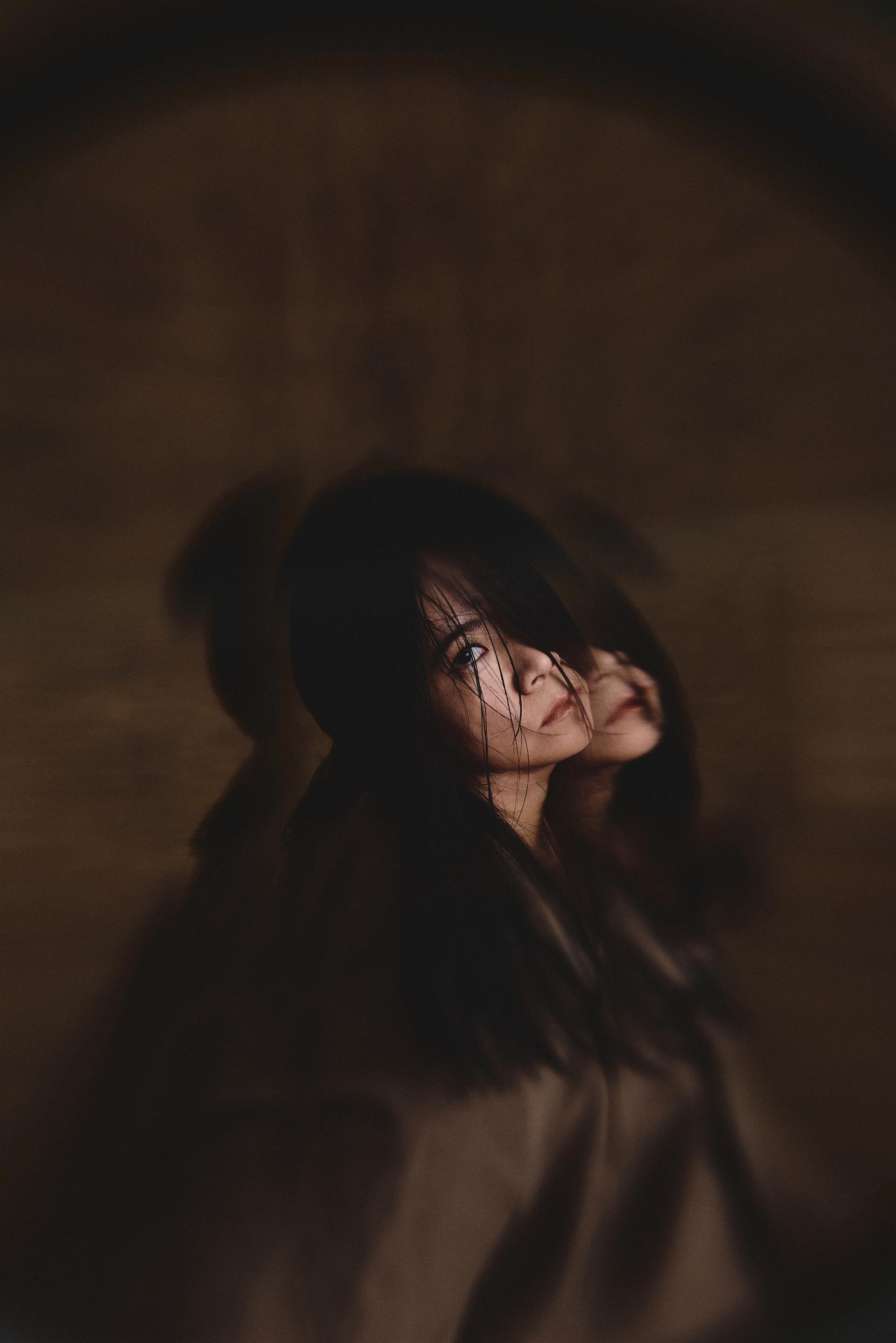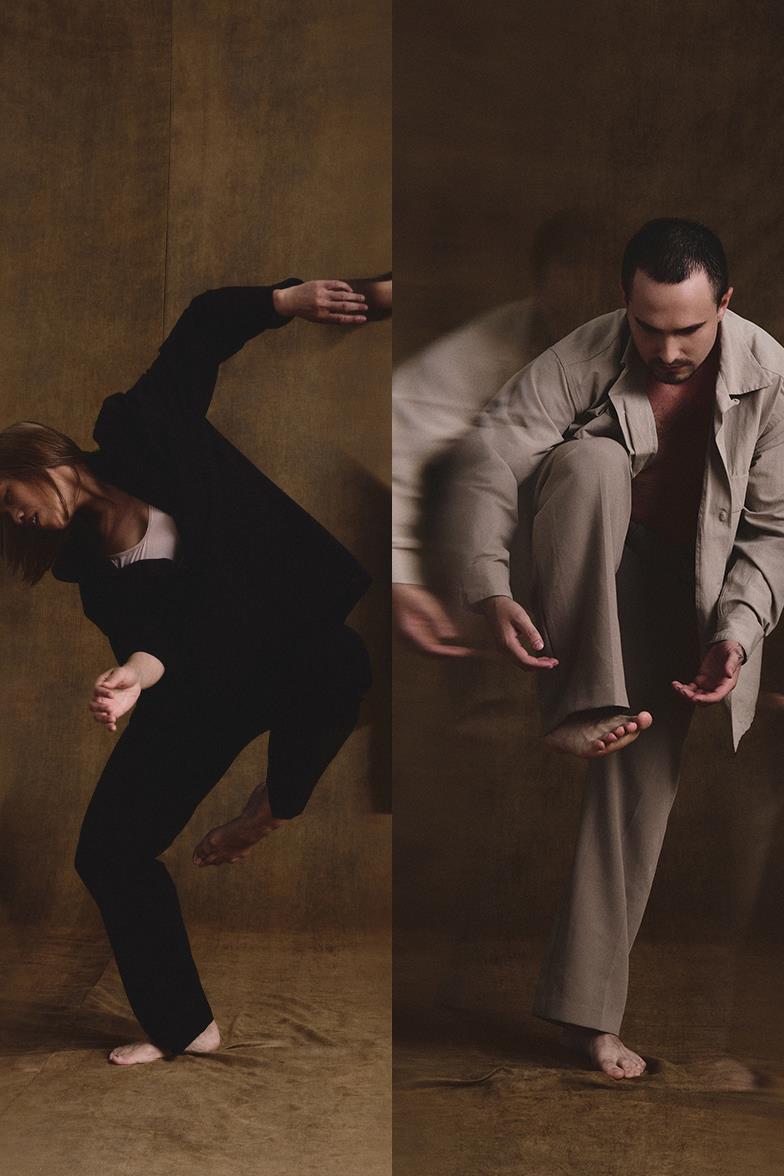本次展演踏上了一條尚未被命名的回返之路,在變動與未知之中,創作者們並非尋求一個穩固的答案,而是透過自身身體與創作行動,摸索出多重位置的可能性。這不只是關於回家,更是關於如何在都市遷徙、族群離散與混血的當代處境中,回應那始終存在的提問——我們從哪裡來,又正往何處去?
五組創作各自立足於個人記憶與族群經驗的交會處——有人將織布轉化為現場儀式,重新啟動身體與時間的關係;有人運用電子聲響與語言迴盪,召喚消逝的部落聲音;有人以舞蹈與物件構築出失根之後的身體地圖;也有作品在都市日常的裂縫中,重新安排族語、祈禱、器物的位置,為觀看者開啟另一種感知之路。
這些作品並不強調單一的歸屬感,而是在模糊、游移、混種的現實中開展各自的創作語言。從部落到都市、從祖靈歌謠到低頻震盪、從編織技法到虛擬影像,它們不斷打開文化的邊界,使「家鄉」不再是被固定在地圖上的地點,而是一種可以被召喚、被行動、被再創的地景。
在此,「移動」不只是地理轉換,更是一種身體選擇與歷史書寫:如何在都市中承接族語的斷裂?如何透過藝術回應主流空間的排除?如何在觀看者與創作者之間建立新的對話位置?這些作品在面對文化被期待詮釋、被制度包裹的條件下,選擇不等待被理解,而是主動書寫自身的位置,將身體化為地圖、將創作化為行動。
本展也意識到展示本身並非中性的空間。每一次展演的安排,都牽動觀看關係、空間權力與語言使用的界線。正因如此,這些作品不僅在回望過往,更是在當下與未來之中,重塑我們與土地、歷史、語言與想像的關係。它們是位置的試探,也是文化的再定位——既不是對傳統的復古式回歸,也不是對當代的簡化性認同,而是在裂縫中尋找生成的可能。
「家鄉在那路彎過去一點」,不是方向的確認,而是一種姿態的展開。創作者從身體出發,在此時此地具現成形,邀請觀者不只是觀看,更共同參與這場召喚與回應的過程。
在《在城市裡整經——pinakaitan》中,詹陳嘉蔚透過排灣族織布儀式中最關鍵的「整經」行動,將祖輩的織紋路徑帶入劇場空間。她用歌謠與身體重現織布前的準備儀式,讓劇場成為一座臨時的「家屋」,召喚都市中流離的原住民身體回到文化的源點。織的不只是線,更是時間與空間交織的認同路徑。
Yukan Yulaw 的《織,造的邊界》則從現代都市中常見的藍白帆布出發,拆解、編織、重構,將原民織藝轉化為對社會邊界的細膩探索。藍白帆布如同遷徙路途上的臨時庇護,也像是都市原民生活的象徵,他在日常與流動之中,建構出一種可以穿越地理、性別與族群界線的視覺敘事。
何晏妤Naceku的《在哪裡的蝸牛》以非洲大蝸牛作為身體與身份的隱喻,投射出他作為卑南族與漢族混血者在都市中游移的身體狀態。蝸牛雌雄同體、行動緩慢、常被忽略,卻堅持爬行於水泥叢林間,正如他在不同文化之間尋找歸屬的身體書寫。冷凍蝸牛成為記憶的保存容器,也是一段文化參與的斷裂紀錄——記憶之路的漫長回返。
Ihot Sinlay Cihek 的《rayrayrayray》則進入後人類的末日廢墟,以阿美族巫師文化為根基,結合AI語音與電子聲響,在廢墟中重建文化記憶的可能性。她的身體成為「因病而巫」的現代巫者,在聲響與神話交錯的時空中穿行,用儀式對抗遺忘,用表演與祖靈對話。這是一種穿越時空的移動,是在斷裂世界中尋求重新連線的精神遷徙。
《回·聲 Sounds of Belonging》由潘巴奈與澳洲原住民編舞家Baden Hitchcock(希貝登)共同創作,在聲音與節奏中探問歸屬的本質。他們從各自族群的身體知識出發,將離散經驗交織成一場聲與身的遷徙。他們所談的不是回到一個已知的家鄉,而是在移動中、在創作裡找到與祖先、土地與自我重新連結的方式。Gida——代表「火苗」的語彙,象徵那仍未熄滅的文化之光,在城市與部落、過去與未來之間閃爍不定。
\ 演出資訊 \
* 時間| 8月15日 (星期五) 至8月16日 (星期六) 19:00-20:30 (兩場皆有演後座談)
* 地點| KIRI 國際原住民族文創園區 (桃園市大園區大成路二段100號)
\索票連結\ https://reurl.cc/0WzVob
\觀眾注意事項\
* KIRI 國際原住民族文創園區可搭乘機場捷運前往,於桃園捷運 A17 領航站下車,出站後往右前方步行約 3 分鐘,即可抵達演出入場地點。
* 本次演出時間為 8月15日(五)至8月16日(六),入場時段為 18:30–19:00,請準時入場。
* 8月15日(星期五)演出當天將進行動態攝影拍攝。
* 建議觀賞年齡為 12歲以上。
* 為避免遲到導致無法入場,建議您提早出發,預留交通與等候時間。
* 本演出形式需隨表演進行移動,入場後請依照現場表演者的引導前往各演出區域,並留意動線與觀賞距離,以確保觀演安全與體驗品質。
* 如於現場感到身體不適,請立即聯繫工作人員,我們將協助您依指示離場。
* 演出現場無設置固定座位,觀眾可站立或席地而坐。若您有特殊需求,請於入場前主動告知服務人員。
* 若需使用電梯,亦請於入場前先行告知,以利安排協助。
This performance embarks on a path of return that has yet to be named. Amidst change and uncertainty, the creators are not in search of definitive answers. Instead, through their bodies and creative actions, they explore the possibility of inhabiting multiple positions. This is not merely about returning home—it is a response to an enduring question within the contemporary realities of urban migration, Indigenous diaspora, and cultural hybridity: Where do we come from, and where are we going?
Each of the five creations emerges from the intersection of personal memory and collective experience. One transforms the act of warping in weaving into a live ritual, reactivating the relationship between the body and time; another uses electronic sound and echoing language to summon the vanishing voices of Indigenous villages. Some construct embodied maps in the aftermath of uprooting through dance and object; others rearrange the position of Indigenous languages, prayer, and artifacts within the fractures of urban life—opening new perceptual paths for the viewer.
These creations do not emphasize a singular sense of belonging. Instead, they articulate their own creative languages within the blurred, shifting, and hybrid realities of our time. From traditional territories to the city, from ancestral chants to low-frequency vibrations, from weaving techniques to virtual imagery—they continuously expand the boundaries of culture. “Home” is no longer a fixed place on a map, but a landscape that can be summoned, activated, and reimagined.
Here, “movement” is not just a geographical shift, but a bodily decision and a rewriting of history: How do we carry the broken threads of Indigenous language in the city? How do we respond through art to the exclusions of dominant spaces? How can new modes of dialogue be formed between artist and audience? Faced with the expectation to interpret culture and the constraints of institutional framing, these works refuse to wait for understanding. Instead, they actively write their own positions—mapping with the body, and acting through creation.
This exhibition also acknowledges that the act of presentation is never neutral. Every decision made in staging performance shapes relationships of viewing, spatial authority, and linguistic use. For this reason, these creations not only look backward, but also intervene in the present and the future—reshaping our relationship to land, history, language, and imagination. They are acts of positional probing and cultural reorientation—not a nostalgic return to tradition, nor a simplistic claim of contemporary identity, but a search for generative possibilities within rupture.
Home? Naluwan a bit over there—this is not a confirmation of direction, but a gesture unfolding. Starting from their own bodies, the artists manifest themselves here and now, inviting the audience not only to watch, but to join in this act of summoning and response.
Warping in the City — pinakaitan, Djubelang draws on the crucial act of warping in the Paiwan weaving process, bringing ancestral textile pathways into the theater space. Through song and movement, she reenacts the preparatory rituals before weaving, transforming the stage into a temporary home. It becomes a site to summon displaced Indigenous bodies in the city back to the cultural source. What is being woven is not only thread, but the intertwined paths of identity across time and space.
In Weaving the Edges of Making, Yukan Yulaw works with blue-white canvas—an everyday material in urban settings—disassembling, weaving, and reconstructing it. He transforms Indigenous weaving into a delicate inquiry into social boundaries. The blue-white tarp evokes temporary shelters along migratory routes and symbolizes urban Indigenous life. From the everyday and the transient, Yukan constructs a visual narrative that traverses geographies, gender, and ethnicity.
Naceku’s Where Are the Snails? uses the African giant snail as a metaphor for body and identity, projecting their own experience as a mixed Pinuyumayan and Taiwanese Han individual navigating the urban landscape. The snail—hermaphroditic, slow-moving, often overlooked—continues to crawl through the concrete jungle. Like them, searching for belonging between cultures. The frozen snail becomes a container of memory and a record of ruptured cultural participation—a long road of remembering.
rayrayrayray by Ihot Sinlay Cihek enters a post-human dystopian ruin, grounded in Pangcah sikawasay—the shamanic tradition—and layered with AI-generated voice and electronic sound. Her body becomes that of a contemporary shaman—called through illness—navigating the temporal and sonic interstices of myth and machine. Through ritual and performance, she fights against forgetting and enters into dialogue with ancestral spirits. This is a migration of spirit across fractured worlds—a movement to rethread cultural memory in a time of disintegration.
Sounds of Belonging, co-created by Pan Panay and Indigenous Australian choreographer Baden Hitchcock, investigates the nature of belonging through voice and rhythm. Drawing on embodied knowledge from their respective cultures, they interweave diasporic experience and imagination into a migration of sound and flesh. What they seek is not a return to a known homeland, but a reconnection with ancestors, land, and self—through movement, through creation. “Gida,” a Motu word meaning “flame,” introduced by Baden, symbolizes the cultural spark that continues to flicker—between city and traditional territories, past and future.
\ Performance Information \
*Date & Time|19:00–20:30, August 15 (Friday) & August 16 (Saturday) (A post-show talk will follow each performance)
*Venue| KIRI Indigenous Cultural and Creative Park (No. 100, Sec. 2, Dacheng Rd., Dayuan District, Taoyuan City)
\Free Ticket Reservation\ https://reurl.cc/0WzVob
\Audience Notes\
* KIRI Indigenous Cultural and Creative Park is accessible via the Taoyuan Airport MRT. Please disembark at A17 Linghang Station and walk approximately 3 minutes toward the right front exit to reach the performance entrance.
* Performances will take place on August 15 (Fri.) and August 16 (Sat.). Audience admission is scheduled from 18:30 to 19:00. Please arrive on time.
* Dynamic filming will take place during the August 15 (Friday) performance.
* Suitable for audiences aged 12 and above.
* To avoid being late and possibly denied entry, please plan ahead and allow sufficient time for travel and check-in.
* This is a mobile performance. Audience members will be guided by the performers throughout different areas of the venue. Please follow their instructions and pay attention to movement routes and viewing distance to ensure both safety and experience quality.
* If you feel unwell at any point during the event, please notify a staff member immediately. We will assist you with exiting the venue if needed.
* There will be no fixed seating in the performance space. Audience members may stand or sit on the ground. If you have specific needs, please inform the staff prior to entry.
* If you require elevator assistance, please notify staff before entering so that arrangements can be made accordingly.

